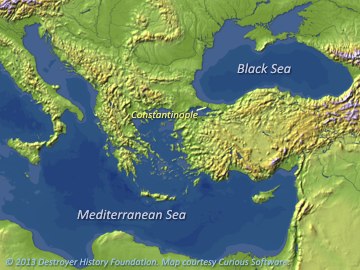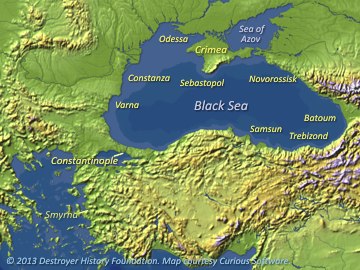USS Scorpion in 1899.
On 4 December 1908, the 12-year-old converted yacht USS Scorpion arrived on station at Constantinople (Istanbul) to commence 15 years of duty in the Ottoman Empire (Turkey). Hers was a colorful career. In the six years before World War I broke out, through earthquakes and two Balkan wars, she aided victims, refugees and Americans caught in disputed areas. From November 1914, three months into World War I, the Ottoman government held Scorpion at Constantinople and, in November 1917, interned her under guard until October 1918, when she resumed assisting prisoners-of-war and refugees.
PARTIAL LIST OF FLUSH DECKERS ATTACHED TO THE BLACK SEA FLEET, 1919–1923
246 Bainbridge
213 Barker
151 Biddle
232 Brooks
219 Edsall
234 Fox
233 Gilmer
247 Goff
231 Hatfield
236 Humphreys
216 John D. Edwards
250 Lawrence
336 Litchfield
220 MacLeish
223 McCormick
237 McFarland
239 Overton
218 Parrott
243 Sands
103 Schley
212 Smith Thompson
114 Talbot
217 Whipple
In 1919, Rear Admiral Mark L. Bristol arrived at Constantinople as the United States’ High Commissioner to the Ottoman Empire and senior US naval officer in Turkish waters. Initially taking cruiser Galveston as his flagship, he coordinated the deployment of 45–50 flush deckers during four years of relief work in the Black and Adriatic Seas, as the Bolshevik Revolution raged across the Black Sea while Mustafa Kemal waged war against the Greeks in Turkey:

Near East, 1919-1923.
- In 1920, Humphries, Overton and Whipple assisted in the evacuation of nearly 150,000 White Russian refugees from the Crimea to Constantinople. As the Red Army approached the Black Sea, they helped evacuate White Russian refugees from the Transcaucasus, taking them to the island of Prinkipo from which they later migrated to Constantinople. Baron General Peter Wrangel, commanding the White Russian forces in the area, pulled his force back to Sevastopol in a desperate rear-guard action. On the morning of 14 November 1920, Whipple, Overton and Humphreys arrived at Sevastopol to find hundreds of boats in the harbor, many of which were crammed to the gunwales with fleeing White Russians. Whipple stood by to evacuate selected individuals bearing passes from Vice Admiral McCully, who was in charge of the evacuation. Whipple’s main battery was trained out and manned at all times. Armed boat crews carried evacuees out to the ship while her landing force stood in readiness. As her last boatload pushed off from shore, Bolshevik troops reached the main square and began firing on the fleeing White Russians. Whipple was the last American vessel out of Sevastopol, towing a barge loaded with wounded White Russian troops out of range of the Bolshevik guns, which she turned the tow over to Humphreys. From Overton’s bridge, Admiral McCully over a megaphone while the Whipple passed, “Well done Whipple.”
- In November 1920, at the end of the Russian Civil War, the Black Sea detachment at Constantinople cruised to Caucasian, Rumanian and Turkish ports to distribute relief supplies, provide communication and transportation and relocate refugees following the capitulation of General Peter N. Wrangel’s anti-Bolshevik White Army to Bolshevik forces in the Crimea. Wrangel and his troops were forced to retreat to Crimea, pursued by both Red and Black Russian cavalry and infantry. Wrangel and the remains of his army were evacuated to Constantinople by the British on 14 November 1920 amidst horrific scenes of desperation and cruelty. Tens of thousands of Russians tried to escape from the Red Army, but were unable to find transport on the overcrowded British ships.
- For 18 months in 1921–22, during a prolonged drought in Russia and resulting potato famine, Gilmer and Fox escorted American grain ships to Russian Black Sea ports.

Destroyer stations in the Black Sea, 1919-1923.
Meanwhile, destroyer commanders passed the word to Admiral Bristol of dramatic and terrible events taking place far inland in Turkey related to a Turkish Revolution and a war between Turkish Nationalists and an invading army of Anatolian Greeks.
In September 1922, during the destruction of Smyrna (Izmir). at the close of the Greco-Turkish War, Litchfield led in evacuating Greek and Armenian refugees while Overton, Lawrence and Edsall also assisted civilian relief agencies in attempting to feed and help coordinate the evacuation of 200,000 ethnic Greeks and Armenians to Greece.
[A detachment of eight destroyers in European waters.]


